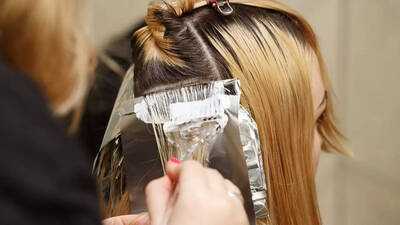Warning! Your hair colour can cause multi-organ failure; understand PPD risks, allergies and safe alternatives
ETimes November 24, 2025 03:39 AM
 Permanent hair dyes are a popular choice for achieving bright, long-lasting hair colour. Many of these products contain a chemical called p-phenylenediamine, commonly known as PPD. This ingredient is essential for keeping hair shades vibrant and resistant to fading. However, experts warn that PPD may pose serious health risks. Regular exposure can lead to skin reactions such as redness, itching, swelling, and blistering. Some individuals may experience allergic responses, particularly those with pre-existing skin conditions. In rare cases, PPD can even cause life-threatening poisoning if ingested. Awareness of these risks is crucial for anyone who colours their hair frequently, allowing safer choices and preventive measures like patch testing.
Permanent hair dyes are a popular choice for achieving bright, long-lasting hair colour. Many of these products contain a chemical called p-phenylenediamine, commonly known as PPD. This ingredient is essential for keeping hair shades vibrant and resistant to fading. However, experts warn that PPD may pose serious health risks. Regular exposure can lead to skin reactions such as redness, itching, swelling, and blistering. Some individuals may experience allergic responses, particularly those with pre-existing skin conditions. In rare cases, PPD can even cause life-threatening poisoning if ingested. Awareness of these risks is crucial for anyone who colours their hair frequently, allowing safer choices and preventive measures like patch testing.
Understanding PPD and why is it used in hair dye
P-phenylenediamine is an aromatic amine that allows permanent hair dyes to retain their colour over time. It reacts with other ingredients to create pigments that penetrate the hair shaft, producing long-lasting shades. Without PPD, hair colour would fade quickly and appear dull. Despite its cosmetic benefits, PPD has been associated with several health risks. Repeated exposure can sensitise the immune system, leading to allergic reactions and skin inflammation. This dual nature makes it a controversial ingredient in hair care products.
Skin reactions and potential cancer risks from PPD in hair dye
Even small amounts of PPD absorbed through the scalp can trigger a range of skin issues. The most common reaction is contact dermatitis, which manifests as redness, itching, swelling, and in some cases, blistering. These symptoms typically appear 48 to 72 hours after hair dye application.
People with pre-existing skin conditions such as eczema, psoriasis, or scalp irritation are more likely to experience adverse reactions. Studies suggest that while 1.5 percent of the general population may react to PPD, the number rises to approximately 6 percent for individuals already prone to dermatitis. There have been questions about the potential link between hair dye chemicals and cancer. The (IARC) has classified occupational exposure to hair dyes as “probably carcinogenic.” However, research on personal use of hair dye shows mixed results.
A 36-year study published in 2020 found no strong overall connection between regular hair dye use and most cancers. It did indicate potential associations with specific types, such as basal cell carcinoma and estrogen receptor-negative breast cancer. Experts emphasise that these findings are not definitive and require further study.
PPD poisoning risks and the importance of careful handling
Although cosmetic use of PPD is generally safe, accidental ingestion of the chemical can be extremely dangerous. Oral exposure can cause rapid multi-organ failure, with early signs including sudden swelling of the neck and airways, known as angioneurotic oedema. Even with prompt medical intervention, severe PPD poisoning carries a mortality rate of around 14.5 percent.
This highlights that while PPD is safe in controlled cosmetic use, awareness and careful handling are crucial.
Safer hair dye alternatives and testing for PPD sensitivity
Growing concern about PPD has led to the development of PPD-free hair dyes . One common alternative is p-toluenediamine sulfate (PTDS). However, research indicates that approximately half of individuals allergic to PPD may also react to PTDS.
The safest approach includes performing a patch test 48 hours before using any hair dye, wearing protective gloves during application, and educating consumers about potential sensitivities. Professional hairdressers should also follow strict safety protocols to minimise exposure. Identifying a sensitivity to PPD can prevent severe reactions. Allergy clinics can provide professional testing, or a patch test at home can indicate whether a person may react to the chemical. The patch test involves applying a small amount of hair dye to a small patch of skin and monitoring for redness, swelling, or irritation over 48 hours.
 Permanent hair dyes are a popular choice for achieving bright, long-lasting hair colour. Many of these products contain a chemical called p-phenylenediamine, commonly known as PPD. This ingredient is essential for keeping hair shades vibrant and resistant to fading. However, experts warn that PPD may pose serious health risks. Regular exposure can lead to skin reactions such as redness, itching, swelling, and blistering. Some individuals may experience allergic responses, particularly those with pre-existing skin conditions. In rare cases, PPD can even cause life-threatening poisoning if ingested. Awareness of these risks is crucial for anyone who colours their hair frequently, allowing safer choices and preventive measures like patch testing.
Permanent hair dyes are a popular choice for achieving bright, long-lasting hair colour. Many of these products contain a chemical called p-phenylenediamine, commonly known as PPD. This ingredient is essential for keeping hair shades vibrant and resistant to fading. However, experts warn that PPD may pose serious health risks. Regular exposure can lead to skin reactions such as redness, itching, swelling, and blistering. Some individuals may experience allergic responses, particularly those with pre-existing skin conditions. In rare cases, PPD can even cause life-threatening poisoning if ingested. Awareness of these risks is crucial for anyone who colours their hair frequently, allowing safer choices and preventive measures like patch testing.